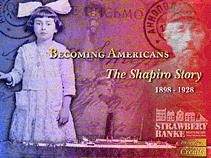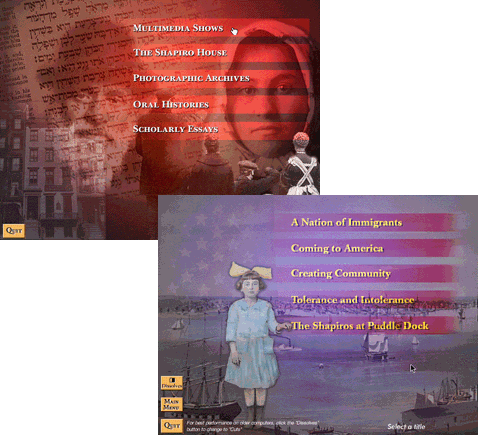
 Becoming Americans: The Shapiro Story The Strawbery Banke museum in Portsmouth New Hampshire is an interesting museum. It is made up of several buildings that have been restored to reflect the cultural history of the area. Each house reflects a different period. The Shapiro House "recreates the home of Ukranian-Jewish immigrants Abraham and Sarah Tapper Shapiro." This CD was developed both for use within the museum itself, as well as for sale to visitors and schools. The CD contains five multimedia presentations. Each is about five minutes long, and combines narration and music with still images. These presentations are actually displayed using a projection system installed at the house. The other modules of the CD are not used in the Museum itself. They include a tour of the house, a photographic archive, oral histories and two scholarly essays. The CD was produced by Michael Schaffer Productions, Cambridge MA. I was the software designed and developer for the disk. Fran Forman was the graphic designer. Short
description of the development But there are differences too. The two major pieces of this project (the Multimedia Shows and the Visit to the Shapiro House) have no equivalents on the Kerouac project. Once again, Director was used to produce this disc because a cross-platform disc was required.
 The Main Menu of the project (top) and the menu for the Multimedia Shows Multimedia Shows The Multimedia Shows (below) are conceptually rather simple. A sound track was prepared and a sequence of images was created to be played along with the images. Putting them together posed a problem however. There were a lot of images in the sequence, and the producer had very specific cue points he wanted for each transition. But the producer wasn't familiar with Macromedia Director (the authoring tool used for this project.) There was also a concern about how the presentation would play on different hardware. To build the presentation I created a very simple "engine"; a program that played the sound track and jumped to the next image in the sequence whenever the mouse was clicked. It also recorded the time at which the mouse was clicked so that it could play back the presentation. The producer could then play the presentation and enter his own timings. If after using the mouse to record the time it still wasn't exactly right, he could manually adjust the time. He could also choose the transition effect. This meant that I didn't have to be present when this was done. The engine was also used to play back the presentation. Because it was playing the presentation based on times stored in a text file, I could do some simple things to try and maintain performance on slower hardware. Specifically, if it got too far behind it would start skipping transition effects to try and catch up. 
| Tour the house | Other modules | |
![]()
Back to Michael D. Murie resume
![]()
DEPARTMENTS
Complete
Guide to Digital Cameras
| ASK
the
Guru
| Multimedia
Online Reference
Archive
Multimedia
Musings
| About
Multimedia Workshop
Home
![]()
Copyright 2000 by Michael D. Murie, Multimedia Workshop. All rights reserved